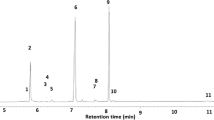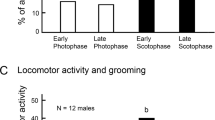Abstract
Swarming locusts show three physical criteria, i.e. the phase changes of melanisation of the nymphal stages or hoppers, of the proportions of certain body parts (morphometric ratios), and increased genetic recombination (meiotic chiasma frequencies) in the adult. The control of these changes, initiated by aggregation into swarms, i.e. gregarisation, seems to be vested in a pheromone which is produced by all hoppers in both the solitaria and gregaria phases, also by hoppers of the albino strain. Such a pheromone can be extracted from the locust room air and from the locust, these extracts showing high activity in bioassays, primarily in increased chiasma frequencies but also in hopper colour. The extract in risella oil is more efficient than that in petroleum ether and can be distilled to yield an active distillate. The pheromone is secreted in the faeces of hoppers but not of adults. There is evidence in faeces bioassays that all three physical criteria are affected; the pheromone may be called locustone. It is manufactured or secreted in a specific section of the alimentary canal, i.e. the crop. Reception is not through the antennae but through the stigmata. Preliminary chemical analysis of a risella oil air extract distilled into various other solvents showed the presence of a relatively simple saturated aliphatic chain with a carbonyl function, perhaps a ketone or an ester.
Similar content being viewed by others
References
Blight, M. M., Grove, J. F., McCormick, A.: Volatile neutral compounds emanating from laboratory-reared colonies of the desert 1 ocust, Schistocerca gregaria. J. insect Physiol. 15, 11–24 (1969).
Ellis, P. E., Carlisle, D. B.: The prothoracic gland and colour change in locusts. Nature (Lond.) 190, 368–369 (1961).
Faure, J. C.: The phases of locusts in South Africa. Bull. ent. Res. 23, 293–424 (1932).
Gillett, S.: Airborne factor affecting grouping behaviour in locusts. Nature (Lond.) 218, 782–783 (1968).
Gunn, D. L., Hunter-Jones, P.: Laboratory experiments on phase differences in locusts. Anti-Locust Bull. (Lond.) No 12, 35 p. 1952.
Highnam, K. C.: Neurosecretory control of ovarian development in Schistocerca gregaria. Quart. J. micr. Sci. 102, 57–72 (1962).
Kinzer, G. W., Fentiman, A. F., Page, T. F., Foltz, R. L.: Bark beetle attractants: identification, synthesis and field bioassay of a new compound isolated from Dendroctonus. Nature (Lond.) 221, 477–478 (1969).
Loher, W.: Die Beschleunigung der Reife durch ein Pheromon des Männchens der Wüstenheuschrecke und die Funktion der Corpora allata. Naturwissenschaften 48, 657–661 (1961).
Nolte, D. J.: A pheromone for melanization of locusts. Nature (Lond.) 200, 660–661 (1963).
—: Phase transformation and chiasma formation in locusts. Chromosoma (Berl.) 21, 123–139 (1967).
—: The chiasma-inducing pheromone of locusts. Chromosoma (Berl.) 23, 346–358 (1968).
—: Chiasma-induction and tyrosine metabolism in locusts. Chromosoma (Berl.) 26, 287–297 (1969).
—, Dési, I., Meyers, B.: Genetic and environmental factors affecting chiasma formation in locusts. Chromosoma (Berl.) 27, 145–155 (1969).
Pener, M. P.: On the influence of corpora allata on maturation and sexual behaviour of Schistocerca gregaria. J. Zool. 147, 119–136 (1965).
Pitman, G. B., Vite, J. P., Kinzer, G. W., Fentiman, A. F.: Specifity of population-aggregating pheromones in Dendroctonus. J. Insect Physiol. 15, 363–366 (1969).
Staal, G. B.: Studies on the physiology of phase induction in Locusta migratoria migratorioides R. et F. Publ. Fds. Landb. Exp. Bur. No 40, 1–125 (1961).
Uvarov, B. P.: A revision of the genus Locusta L. (= Pachytylus Fieb.) with a new theory as to periodicity and migration of locusts. Bull. ent. Res. 12, 135–163 (1921).
Wilson, E. O.: Pheromones. Scientif. Amer. 208, 100–110 (1963).
Author information
Authors and Affiliations
Rights and permissions
About this article
Cite this article
Nolte, D.J., May, I.R. & Thomas, B.M. The gregarisation pheromone of locusts. Chromosoma 29, 462–473 (1970). https://doi.org/10.1007/BF00281928
Received:
Accepted:
Issue Date:
DOI: https://doi.org/10.1007/BF00281928




